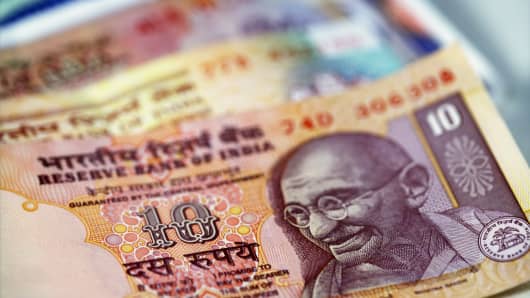Inflation appears to have finally turned a corner in India, heightening the prospects for an interest rate cut at the end of the month, and one of the biggest beneficiaries could be the rupee, said market watchers.
India's headline inflation for December came in at 7.18 percent, its lowest level in three years - against forecasts of 7.4 percent - marking three consecutive months of declines. This offers room for the Reserve Bank of India (RBI) to support growth via a rate cut, which in turn could improve the sentiment for the country's flagging currency, said analysts.
"The markets will cheer a rate cut, and that could elicit capital inflows. Anything that restarts growth and the investment cycle will be positive for the rupee," Aninda Mitra, head of Southeast Asia economics at ANZ told CNBC on Monday.
Mitra, who expects a 25 basis point rate cut during the RBI's policy meeting on January 29, sees the rupee strengthening to 51.50 against the U.S. dollar over the next 12 months, a gain of about 6 percent higher from current levels.
While rate cuts are typically negative for a currency, in the rupee's case it will not be, added Vishnu Varathan, market economist, Mizuho Corporate Bank, as easier monetary policy would indicate commitment by the central bank to support growth. He also forecasts a 25 basis point rate cut at the upcoming meeting.
(Read More: What Will It Take for India to Cut Rates?)
Despite growth slumping to multi-year lows in 2012, growing inflationary pressures led the central bank to adopt a cautious stance. It cut interest rates just once in April by 50 basis points.
Varathan, who sees the rupee ending the year at 50 against the greenback, added, "easing inflation also means that there will be fewer risks for a deteriorating fiscal deficit as there are less subsidies required."
Unlike India's stock market, which was among the best performing in Asia in 2012, the rupee remained volatile last year, owing to concerns over the country's twin deficits – both current account and fiscal – and slower economic growth.
While the currency gained traction after the government announced a slew of long over-due measures to boost investment in September, it failed to sustain the positive momentum, weakening 3.5 percent against the dollar over the course of the year. But, moves by the central bank to stimulate growth in 2013, alongside a continuation of government reform efforts, could drive a turnaround in the currency this year, said experts.
(Read More: Top Performing Currency in 2013? Not What You Think)
"The rupee is dependent on domestic factors – the economic recovery and the extent to which the inflation problem is coming under control – and continued progress on structural reform implementation," said Leif Eskesen, chief economist for India and Southeast Asia at HSBC, adding that global risk sentiment will also play an important role in determining the direction of the currency.
"Moving into the second-half, global economic conditions will be better. If you look towards end of 2013 – the rupee should end the year at 50," he said.
Inflation Trend
While the trend in inflation has turned, it is unlikely to ease significantly from current levels, added economists.
"Inflation has most likely peaked out, but the prospects are for inflation coming down gradually because it is more structurally embedded. India is starting to make progress, but the implementation of policies is gradual, so the fall in inflation will be gradual as well," Eskesen said.
Consumer price inflation in December was higher than expected at 10.56 percent, indicating that broader inflation pressures remain quite firm, he added.
Varathan agrees that headline inflation is unlikely to decelerate into the RBI's comfort zone of 4-5 percent, however it will likely remain in the 6.5-7.5 percent range this year.



